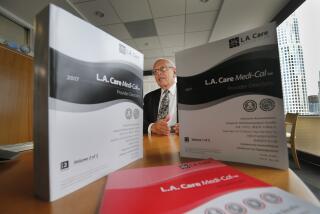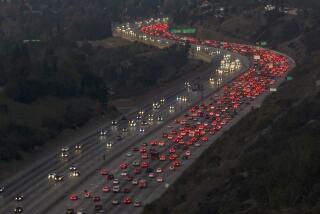Someone Else Gets What You Pay for : Auto Insurance: Coverage is mandatory; the assigned-risk plan is supposed to pay its own way. Enforcement of both laws would bring down premiums.
In California, auto accidents are a certainty. They occur at the rate of 48,000 per month, or 66 per hour. About 24% involve drivers who have caused one or more collisions within the previous two years. There are about 650 auto accidents per day involving death or injury, and more than half of those involved drunk drivers or drivers who had been drinking.
In the view of many, these drivers should not be allowed on the streets. Moreover, about 15% of the drivers in Los Angeles County are uninsured, and more than 9% of insured drivers are covered under the state’s assigned-risk plan. Those of us who are insured pay more than half of the premiums for assigned-risk drivers. Although the law creating the plan requires that premiums cover claims and costs, the usual interest groups prevail annually, preventing increases which would ensure that assigned-risk drivers pay their fair share. For example, an assigned-risk driver in Culver City, with bodily injury coverage of $15,000 per injury and $30,000 per occurrence pays $447 annually. But a driver of the same age, in the same area, with the same model vehicle, who has a perfect driving record--no violations, no accidents--will pay $504 to $695 for a regular policy with the same coverage.
Besides paying less, assigned-risk drivers have between 2 1/2 and three times more accidents.
You and I subsidize these drivers through higher rates on our policies. Because of the bargain rate, many drivers who qualify for a regular policy are purchasing assigned-risk coverage. The assignment of high-risk drivers to our insurance companies will cost about $2 billion in claims and administrative costs in 1989. Premiums from these drivers will total $1 billion. The shortfall is made up by regularly insured drivers.
This is one area in which we can lower our rates--just enforce the law to make assigned-risk premiums cover assigned-risk costs. One major Southern California insurer estimates that 15% of the bodily injury and property damage premium is attributable to these subsidies.
We also subsidize uninsured motorists. The state requires that insured drivers carry uninsured-motorist coverage, unless we specifically decline it. This covers us only for personal injuries, up to $15,000 per injury and $30,000 per occurrence. This type of coverage in the central area of Los Angeles, where as many as 60% of the drivers are uninsured, costs as much as $350 per car. We pay for these uninsured motorists through the “collision” portion of our policies. It is estimated that 15% of the collision premium is attributable to uninsured motorists. We also pay directly for these motorists in the deductible portions of our collision coverage and for all the repairs or a replacement vehicle if we have no collision coverage.
The uninsured and those who resist increases in assigned-risk rates claim that they cannot afford insurance. Of course, they can afford to pay for gas, oil, repairs, collision coverage required by auto finance companies, monthly lease or purchase installments, car registration, etc.
If legally required minimum insurance is not affordable, the driver must make choices. A family with two cars may have to give up one or buy a less expensive car. Public transportation is another alternative. In any case, the Legislature has already established, by law, that requirements for minimum coverage be observed and that assigned-risk premiums cover the costs of the plan. We do not tolerate other violations of law based on the violators’ income, and we should not do so here, where the potential for death, injury and destruction is so great.
Enforcement of these laws is long overdue. It need not be difficult. The state insurance commissioner should immediately comply with the law requiring adjustments to assigned-risk premiums to cover costs. As for mandatory coverage, there should be a vehicle registration system tied to insurance. Under such a system, all policies would be required to provide at least the minimum level of insurance for a year, coinciding with the vehicle-licensing cycle. Insurers would send evidence of non-cancelable insurance for the registration period to the Department of Motor Vehicles. Vehicles without current registration would be towed and impounded until registered.
Much more can and should be done. For example, substantial reductions could result from implementation of a genuine “no fault” plan--such as those in New York and Florida--which would eliminate most wasteful lawsuits and fraud.
These measures alone could provide a large reduction in premium for the average policyholder in Los Angeles County and eliminate the biggest part of the financial loss attributable to uninsured and bad drivers.
More to Read
Inside the business of entertainment
The Wide Shot brings you news, analysis and insights on everything from streaming wars to production — and what it all means for the future.
You may occasionally receive promotional content from the Los Angeles Times.










